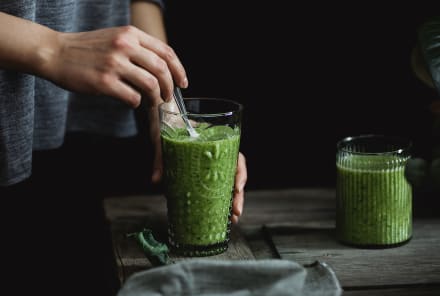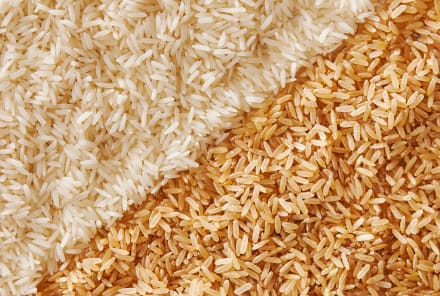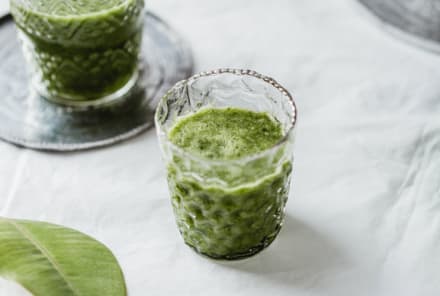Advertisement
How Much Vitamin C Is In An Orange? & Do I Need More For Optimal Health


Ashley Jordan Ferira, Ph.D., RDN is Vice President of Scientific Affairs at mindbodygreen. She received her bachelor's degree in Biological Basis of Behavior from the University of Pennsylvania and Ph.D. in Foods and Nutrition from the University of Georgia.
Vitamin C, aka L-ascorbic acid, is a water-soluble vitamin that's a crucial part of your diet. Vitamin C does a lot in your body, including helping with collagen production, supporting immune health, and more.*
When it comes to getting your vitamin C fix through food, it's only natural to think of oranges. But how much vitamin C is there in an orange, really? While the citrus fruit does contain the crucial nutrient, it's not the only way to get vitamin C in your life. Here's what you need to know.
How much vitamin C is in an orange?
So, how much vitamin C is in an orange? One medium orange contains approximately 68 milligrams of the nutrient, according to nutrient analysis data from the U.S. Department of Agriculture (USDA)1.
Worth pointing out: A ¾-cup serving of orange juice actually contains a little more vitamin C than the actual fruit—it has a concentrated dose of around 93 milligrams of vitamin C. Although, the whole fruit delivers more fiber, especially if you keep the white, spongy pith intact.
Fruits & veggies with more vitamin C than an orange.
While oranges get plenty of attention when it comes to vitamin C, they're not the only fruit (or vegetable) that's packed with the nutrient. Here's a breakdown of others that either top the orange's vitamin C capacity or come close, per the USDA food database2:
- Red pepper (½ cup): 95 milligrams
- Grapefruit juice (¾ cup): 70 milligrams
- Kiwi fruit (medium): 64 milligrams
- Green pepper (½ cup): 60 milligrams
- Broccoli (½ cup): 51 milligrams
- Strawberries (½ cup): 49 milligrams
- Brussels sprouts (½ cup): 48 milligrams
How much vitamin C do I really need daily?
Like many vitamins and nutrients, the recommended dietary allowance (RDA) for vitamin C varies based on your age, gender, and what's happening in your life.
Adult men aged 19 and up should strive for a baseline intake of 90 milligrams of vitamin C daily, according to the National Academies3, while adult women should consume at least 75 milligrams. That goes up slightly when you're pregnant (85 milligrams) and breastfeeding (120 milligrams).
"These are just general recommendations," says health coach, registered dietitian, and mbg Collective member Jessica Cording, R.D., CDN. "In terms of what's considered the optimal amount for you, it can vary. You may have higher needs during different times in your life." But she notes that at a minimum, you should aim for the RDA.
It's also worth noting, 42% of U.S. adults4 are insufficient in vitamin C (per blood test results), while 118 million American adults are failing to consume adequate amounts of vitamin C5 daily from their diets. (More on that here.)
In general, if you take in more vitamin C than you need at that moment, you'll just pee out the excess, says Zhaoping Li, M.D., Ph.D., director of the Center for Human Nutrition and chief of the Division of Clinical Nutrition at David Geffen School of Medicine at UCLA. "If you have more than you need, your body will get rid of it."
Li adds, if you have a "megadose," you may run the risk6 of experiencing unwanted side effects. The National Academies defines the tolerable upper intake level (UL) as 2,000 milligrams per day7. To clarify, the UL is defined as "the highest level of daily nutrient intake that is likely to pose no risk of adverse health effects to almost all individuals in the general population." (More on those potential health considerations here.)
Benefits of vitamin C.
"Vitamin C has several important functions within the body—including proper immune system function8, tissue healing, collagen formation9, maintenance of bones and cartilage, and optimal absorption of iron,"* registered dietitian nutritionist Emily Achey, M.S., R.D., INFCP, previously told mindbodygreen.
Vitamin C is the body's primary water-soluble antioxidant, which serves an important role in neutralizing free radicals and combating reactive oxidative species (ROS) throughout the body.* It can even help regenerate8 other antioxidants in your body, like vitamin E and glutathione—which work alongside vitamin C to protect different cells and tissues throughout the body.*
Research also suggests that sufficient levels of vitamin C are needed to support memory and cognitive function10.* (You can also check out the full, detailed rundown of benefits here.)
Do I need a vitamin C supplement?
It depends. "Vitamin C can be easily be found in fruits and vegetables," says Keri Gans, R.D., author of The Small Change Diet. That's why Cording recommends taking a good look at your diet to see if supplementation is right for you. "What needs are you covering with food, and where do you have some gaps?" she asks. "If you're falling short of vitamin C intake from food, then that's a good indication to consider a supplement." And, she adds, "if you need a little extra help with immune system function, it might be a good time to take additional vitamin C."*
And beyond a gap-filling approach, the science on vitamin C demonstrates benefits for higher potency dosing (i.e., 500 mg to 1,000 mg), depending on your goals. For example, when optimizing our immune response11 or for the reduction of C-reactive protein (an inflammatory biomarker) and supporting cardiometabolic health (e.g., blood pressure12), the science on high-potency C dosing is compelling.*
Bottom line.
While oranges are a good source of vitamin C, they're not the only way to get your recommended dose of the nutrient. Other fruits and vegetables, along with supplementation, can help you meet your goals.*
12 Sources
- https://fdc.nal.usda.gov/fdc-app.html#/food-details/169097/nutrients
- https://fdc.nal.usda.gov/fdc-app.html#/
- https://www.ncbi.nlm.nih.gov/books/NBK225483/
- https://www.mdpi.com/2072-6643/13/11/3910/htm
- https://www.ncbi.nlm.nih.gov/labs/pmc/articles/PMC7352522/
- https://ods.od.nih.gov/factsheets/Vitaminc-HealthProfessional/#h19
- https://www.ncbi.nlm.nih.gov/books/NBK225480/
- https://pubmed.ncbi.nlm.nih.gov/12134712/
- https://ods.od.nih.gov/factsheets/Vitaminc-HealthProfessional/#h4
- https://www.ncbi.nlm.nih.gov/labs/pmc/articles/PMC4179190/
- https://www.ncbi.nlm.nih.gov/labs/pmc/articles/PMC7589163/
- https://www.ncbi.nlm.nih.gov/labs/pmc/articles/PMC3325833/
Watch Next
Enjoy some of our favorite clips from classes
Enjoy some of our favorite clips from classes
What Is Meditation?
Mindfulness/Spirituality | Light Watkins
Box Breathing
Mindfulness/Spirituality | Gwen Dittmar
What Breathwork Can Address
Mindfulness/Spirituality | Gwen Dittmar
The 8 Limbs of Yoga - What is Asana?
Yoga | Caley Alyssa
Two Standing Postures to Open Up Tight Hips
Yoga | Caley Alyssa
How Plants Can Optimize Athletic Performance
Nutrition | Rich Roll
What to Eat Before a Workout
Nutrition | Rich Roll
How Ayurveda Helps Us Navigate Modern Life
Nutrition | Sahara Rose
Messages About Love & Relationships
Love & Relationships | Esther Perel
Love Languages
Love & Relationships | Esther Perel











